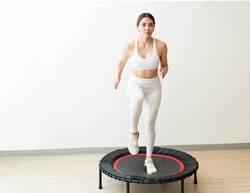Running is a simple way to build cardio fitness and stamina when added to a weekly routine. With a gradual start and consistent sessions, most beginners adapt quickly and notice smoother breathing, stronger legs and faster recovery.
What happens to your body when you run every week
“Running can be a shock to your body at first. The heart begins to work harder, the lungs are learning to keep up with your breathing, and the legs and core are adjusting to this extra demand,” says certified fitness trainer Tabthea Lomo. “The first few runs should feel tough, however endurance builds fast, so consistency is key. Remaining consistent will help you breathe easier and recover quicker after each run.”
Personal trainer and fitness coach Claudette Sariya agrees. “When you start running, your entire body begins to wake up. You activate your quads, glutes, calves and core with every stride. The first kilometre often feels like an uphill battle, but by the second you’re warmed up and ready to take on the rest.”
New runners benefit from steady progression, mobility work and the right kit. Supportive running shoes, high-support sports bras and comfortable shorts help maintain form. A running belt can keep essentials close. Anyone with a medical condition should follow personalised advice from a GP or specialist before changing exercise routines.
Benefits of running
May lower blood sugar in those with diabetes
Responses vary, but regular running can improve insulin sensitivity and help some people with diabetes manage blood glucose. Anyone using insulin or glucose-lowering medicines should speak with a GP or specialist and monitor closely to avoid hypoglycaemia.
Boosts heart strength
“Running can be a shock to your body at first. The heart begins to work harder, the lungs are learning to keep up with your breathing, and the legs and core are adjusting to this extra demand,” says Lomo. With consistent training, resting heart rate may decrease over several weeks as stroke volume improves and the cardiovascular system becomes more efficient. “Your body also builds more mitochondria, which supports energy production,” adds Sariya.
Builds muscle
Running recruits the quads, glutes, calves and core. Some research on high-intensity running shows increases in muscle fibre volume in young adults, though more studies are needed on different running styles and age groups.
Improves stamina
As aerobic capacity rises, breathing feels easier and recovery speeds up session to session. “The first kilometre often feels like an uphill battle, but by the second you’re warmed up and ready to take on the rest,” says Sariya.
Supports healthy bones
Weight-bearing impact helps signal bone formation. Small studies suggest runners show favourable markers linked to bone growth compared with non-runners, though more research is needed. Progress impact gradually and consider strength work to support joints.
Helps with stress relief
“Mentally, it’s a natural stress reliever—that runner’s high is very real,” says Lomo. Regular running is also linked with better sleep, steadier daytime energy and a confidence lift from building capability.
May lead to weight loss
Running typically burns more kilojoules per minute than walking at the same duration. Combined with a balanced diet and strength training, it can support a sustained energy deficit and healthy body composition.
Potential downsides
Experts say risks are low when running is introduced with a plan. “The problems usually appear when people rush in without structure or progression,” says Sariya “Expect some soreness in the first few sessions, but that is temporary. Jumping straight to high volume without experience increases the chance of injury. Listen to your body, be patient and build intensity as consistency improves.”
Common issues to watch for
- Delayed onset muscle soreness in the calves, quads and hips
- Overuse injuries such as shin splints, tendinitis or a calf or hamstring strain
- Knee or ankle discomfort from sudden increases in distance or pace
- Flare-ups of old injuries
- Low blood glucose in people using insulin or glucose-lowering medicines
Reduce the risk
- Progress gradually, increasing total time or distance by small amounts each week
- Add two days of strength work for legs and core to support joints
- Warm up with dynamic movements, cool down with easy walking and light mobility
- Rotate or replace worn shoes and run on mixed surfaces where possible
- Schedule rest days and include low-impact cross-training
- If managing a health condition, follow personalised advice from a GP or specialist and monitor symptoms closely
The bottom line
Running is not essential for everyone, but many people can run safely with a gradual plan. Start with walk-run intervals, build steadily and pair training with strength, mobility and adequate recovery. If pain is sharp, persistent or affects daily movement, stop and seek professional guidance. Choose the approach that fits your body and lifestyle, then progress at a pace you can maintain.










